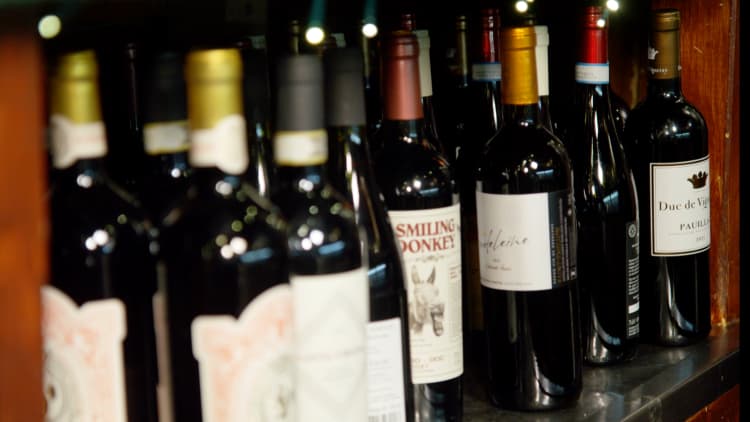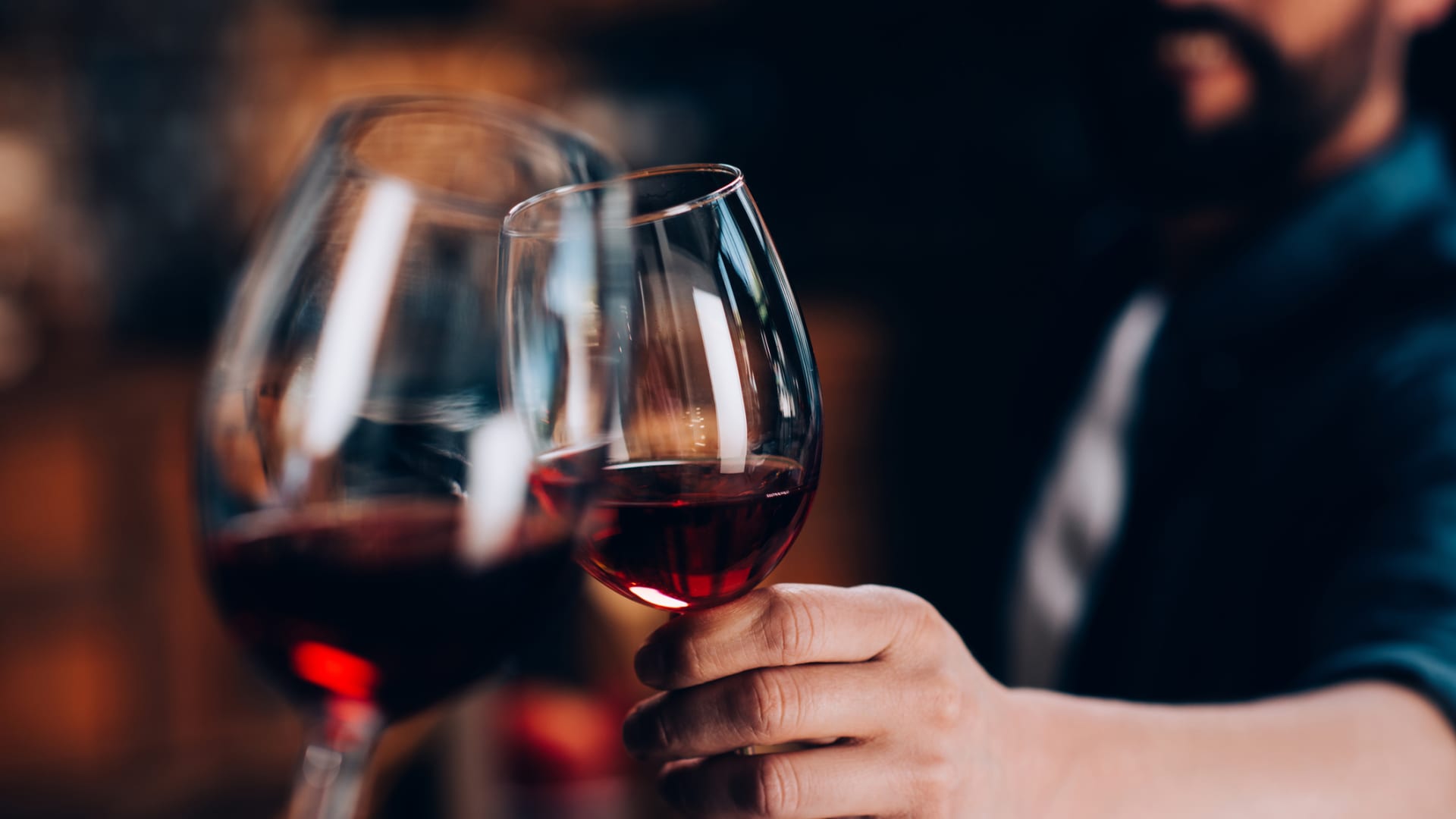BEAUJOLAIS, FRANCE — “There are few things in life that can’t be enhanced by a fine wine,” reads a translation of a sign in Villefranche-sur-Saône, Beaujolais, as the French wine region marks its new season.
That’s a motto that’s increasingly being applied to investments, as oenophiles and investors alike seek to diversify their portfolios with a more eclectic mix of assets.
With low correlation to the global stock market, a good collection of the alcoholic stuff can be an excellent accompaniment to traditional investments. But not all wines are made equal, and knowing where to start can require a seasoned palate.

“Unlike enjoying a bottle of wine where you open it, you drink it with friends and you have a great time, there are many, many years of learning and understanding that go into appreciating fine wine,” Nick Pegna, Sotheby’s global head of wine and spirits, told CNBC.
“That, I think, is very appealing: It is an intellectual as well as a hedonistic experience for people.”
Rewarding returns
Fine wine consistently ranks as one of the best-performing alternative asset classes within the Knight Frank Luxury Investment Index, which compares the annual returns of collectibles including art, watches, cars and handbags.
Over the past 10 years, fine wine prices have risen 149%, the second-highest return of any alternative investment after whiskey (322%) — and well ahead of cars, coins and jewelry.
It’s not a short-term play; never has been. Certainly, wine is a five years minimum.
Anthony Maxwell
chief commercial officer at Liv-ex
The most celebrated bottles among them grew even more, with wines from France’s Burgundy region — celebrated for its pinot noir and chardonnay grape varieties — increasing 214% over the same period.
However, as with the aging process itself, investing in fine wine typically takes time and a strong stomach.
Prices fell 11.3% in the year to October, retreating from a high base after a Covid-induced rally, according to the Liv-ex Fine Wine 100 benchmark, which tracks the 100 most traded fine wines on the secondary market.
“It’s not a short-term play; never has been,” said Anthony Maxwell, chief commercial officer at the wine trading marketplace. “Certainly, wine is a five years minimum, it’s a medium outlook and beyond.”
Honing your taste
Investors looking to enter the wine market can think of the investment as a piece of art, according to experts, with quality, rarity and provenance all key factors to consider.
“It needs to improve with age in the bottle, there needs to be some brand recognition, and — perhaps crucially — it needs to have a resale value,” Maxwell said.
Investors looking to enter the wine market should consider factors including quality, rarity and provenance.
Jeff Pachoud | Afp | Getty Images
For that, research is key, said Maxwell, noting that improved access to data over recent years has made it easier for new entrants to assess brands’ ratings, critical acclaim, production processes and consumption rates.
“With better data, with more transparency, it has helped turn what was maybe a bit of a bit of a closed club, a closed shop, into something far more approachable for far more people,” he said.
Still, underneath the facts and figures, investors should also have a true enthusiasm for wine, experts agreed.
“It’s a passion,” Pegna said. “If you don’t enjoy drinking great wines then it becomes a rather boring investment class.”
Buying at auction
Wineries and wine merchants can be an excellent starting point for investors looking to access young wines at a lower price to he held for the long term. Auction houses, meanwhile, provide access to already highly esteemed brands and collectible bottles.
Currently underway at Sotheby’s is a year-long sale of 25,000 bottles curated by Taiwanese art collector and businessman Pierre Chen, with auctions being held in Hong Kong, Paris, Burgundy, New York and London through late 2024.
The collection, titled “An Epicurean’s Atlas,” is expected to fetch up to $50 million across the five sales, which Sotheby’s Pegna said spoke to the highly lucrative nature of the market. A magnum of Henri Jayer Vosne Romanee Cros Parantoux 1er Cru, for example, set to garner around $70,000.
There is a huge amount of new interest. Nearly half of our new buyers are coming from the U.S.
Nick Pegna
Global head of wine and spirits at Sotheby’s
“What is clear is that [Chen] was exploring vineyards in Burgundy in the early days before people were really spending much time there. But he’s also taken some expert advice in building it up,” Pegna said.
The sale comes as increased accessibility and a growing consumer base have sparked a boon in the market.
Fine wine auctions at Sotheby’s have almost tripled in value in the past decade, rising from $58 million in 2013 to $158 million in 2022. Over the same period, the number of bidders has increased by nearly 400% and the number of new bidders by almost 500%, two-thirds of whom are in their 30s and 40s.
“There is a huge amount of new interest,” Pegna said. “Nearly half of our new buyers are coming from the U.S., but also the younger demographic.”
Things to consider
Unlike many traditional investments, chattels, or tangible assets such as wine, are often exempt from capital gains tax, adding to their appeal. However, it is important to seek local advice and factor in the costs of trade, which can eat into overall returns.
“You’ve got to be prepared to accept 10% on the way in and 10% on the way out,” Maxwell said.
Depending on the size of the collection, storage is also an important consideration. Experts recommended storing the wine in bond — or authorized storage facilities — which are typically exempt from tax implications, such as VAT, and can help protect the integrity of the bottles.
They can also prevent any “fits of enthusiasm” to taste it, Pegna noted.
Autumnal vineyards in France’s Beaujolais region, weeks after the “vendage” season, when grapes are harvested.
Karen Gilchrist | CNBC
Lastly, decide ahead of time which bottles you’re buying to “lay down” — or store — and which you plan to drink.
“Often, people rationalize what they’re doing in terms of investment and then change their minds later on because they come to love the collection and want to drink it,” said Pegna. “If you can, make the decision upfront about what is being bought to lay down and what you’re looking to drink.”
As for the experts’ hot tips for the next investible tipple? Well, according to Maxwell, there’s one often overlooked vintage.
“You could definitely do worse than buying a few cases of 2016 Bordeaux,” he said. “And if everything goes wrong, you’ll have some delicious wine to drink at the end of it.”

